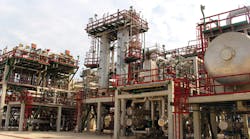Demand patterns for global LPG trade will change in the near term, according to New York-based Poten & Partners, a global broker and commercial advisor for energy and ocean transportation industries, in its December issue of LPG in World Trade.
In the same study, the consultancy explained recent unexpected patterns in Chinese LPG supply and demand in terms of one dynamic: price.
Poten & Partners noted the reversal in West-to-East LPG trade patterns that had dominated global trade for the last 5 years; trade is now East-to-West. This contrasts with LNG trade patterns in which tight supplies have been and will continue to move to the East.
Until 2008, targeted LPG retail growth markets in the East have been the large populations of China, India, and Indonesia. But China’s LPG demand “has stalled,” said the consultant. India’s LPG markets are hampered by continuing domestic price subsidies. And in Indonesia, the “problem is infrastructure.”
Markets in these countries will not “be able to absorb the increasing LPG volumes on the international market,” according to the study.
Poten & Partners noted that rising LPG imports to China 2002-04 had once underpinned demand growth in the Far East. Investors looking in the future, however, failed to see the extensive new refinery capacity developing in China’s hinterland and to anticipate fully the added LPG production that would result. Import infrastructure for LPG that developed at the time was underutilized, as a result.
Rather than growing, Chinese LPG imports have fallen since their 2004 peak. For 2008, says the consultancy’s analysis, LPG imports were 2.4-2.6 million tons, compared with 8 million tons for 2004.
This unexpected trend—China’s disappearance from the international market—can be explained by price: “High and rising international prices since 2004 forced China out of the market.”
The downward trend of Chinese LPG imports appeared to have reversed in November 2008, when Chinese buyers bought 130,000 tons of spot November LPG deliveries. “The impetus [was] again price—international prices [had] fallen below domestic prices which although deregulated are based on government-controlled crude prices,” said Poten & Partners.
The recent supply and demand dynamics in China’s LPG market since 2004, before which China was the Far East’s second-largest LPG importer, are unlikely to end soon. Major changes have occurred to the amount of LPG produced in Chinese refineries and to those consuming the LPG, says the Poten study.
To compensate for the effects of government control of markets for refined products in China, refiners often “maximize their LPG production to capitalize on comparatively lucrative free-market LPG sales.” A surge in Chinese refining capacity since 2000 has effectively backed LPG imports out of China.
Barring changes to the regulatory structure, says Poten & Partners, China’s refiners will “continue to maximize LPG production over that of other products until refinery gate prices reach a floor set by the international LPG market.”
On the consumption side, many “light industrial units have closed since the start of [2008], taking with them valuable outlets for LPG.”
In summary, says the consultancy, “domestic LPG production capacity is high and growing while LPG will lose some of its demand base for the short term at least.”
